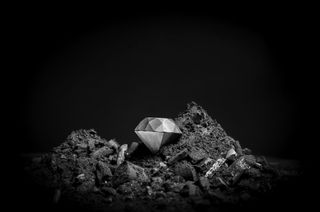
Ask most people what words they associate with diamonds, and they’ll say “proposal”, “love”, “down on one knee” or “three months’ salary”.
But if you work in the mining industry—or if you’re a huge Minecraft nerd—diamond takes on a different meaning entirely. It’s the hardest naturally occurring substance on Earth, much more durable than common industrial material like hardened steel. Whether you’re building a real-world drill or a virtual pick-axe, you’d pick diamond over anything else.
Why, then, is iron or steel more commonly used? Besides diamond costing much more to mine, it’s also incredibly difficult to carve into a useful shape; your sculpting tool will break before the diamond will. Or, try smelting diamond like you would iron, and it will oxidize (read: burn up into CO2). Building a diamond suit of armor or house isn’t as easy as Minecraft wants you to think.
Sandvik is using additive manufacturing to change that. Using a 3D printer, a semiliquid blend of diamond powder and polymer, and ultraviolet light, Sandvik successfully created the first-ever 3D-printed diamond composite.
“The additive manufacturing process used is highly advanced,” Mikael Schuisky, Head of R&D and Operations at Sandvik Additive Manufacturing, explains. “We are printing in a slurry consisting of diamond powder and polymer using a method called stereolithography, where complex parts are produced, layer by layer, using ultraviolet light.”
Using its stereolithographic (SLA) printer, Sandvik dips a metal contraption into the slurry; cures a thin layer of slurry using UV light, hardening it into a sliver of diamonds and polymer; lifts this top layer out of the slurry to congeal completely; douses it back into the slurry to cure the next layer; and repeats ad nauseam until the whole model is printed.

Unfortunately, if readers clicked on this article hoping to find a how-to guide for 3D-printing their own DIY engagement ring, we have to share some bad news: it turns out that molding diamond powder into a gem is the easy part, but not the whole process.
The challenge comes from transforming the weak diamond-polymer body into a solid diamond composite, keeping most of the pure diamond’s extraordinary properties. To achieve this, Sandvik uses a “proprietary post-processing technique”, in its own words, that cements the diamond into the indestructible form you see above.
Whatever secret process Sandvik uses, it allows them to turn their synthetic diamond into a material that is “three times stiffer than steel, with heat conductivity higher than copper, the thermal expansion close to Invar – and with a density close to aluminium”, according to Anders Ohlsson, Delivery Manager at Sandvik Additive Manufacturing.

So while this diamond may not be pure carbon—and you won’t want to wear it anytime soon—the implications of this technology go far beyond mimicking the shape of a diamond ring. Sandvik can build a diamond prototype of any shape you can conceive of and design in 3D modeling software, replacing tools made out of materials like copper or steel.
Several industries already rely on diamond materials. Miners and the military use diamond-infused oil to optimize their drills and cutters. Computer makers are replacing silicon with diamond in their semiconductors for better heat resistance. Because diamonds can vibrate without deforming, they’re used in record player needles and speaker systems. A Canadian tech startup is even attempting to build bionic diamond retina implants for the visually impaired.

With Sandvik’s 3D printing technology, diamond-based technology could be much easier to design, and then mass produce, for a variety of industries. While a diamond’s exterior can eventually be carved into a specific shape, Schuisky notes that “you can do features inside these types of materials that’s never been done before.”
Ohlsson claims that within a few years, “space programs” and construction companies will be building wear-proof prototypes and equipment using Sandvik’s 3D printed diamond composite. And who knows, maybe Minecraft enthusiasts will get the chance to custom order some real-world diamond swords and armor.
Get daily insight, inspiration and deals in your inbox
Get the hottest deals available in your inbox plus news, reviews, opinion, analysis and more from the TechRadar team.
